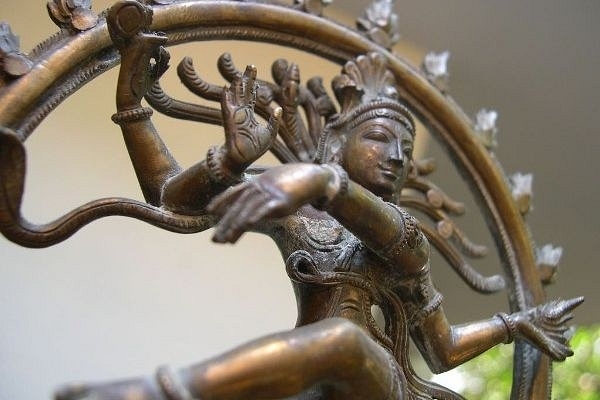Culture
Thiruvathirai: The Dance Of Shiva At Every Level
- Understanding what 'Thiruvathirai' signifies — at an individual, social, cultural and cosmic level.

The Nataraja (Balu Velachery/Flickr)
Today is Thiruvathirai — the day of the Cosmic Dance of Shiva.
Thiruvathirai relates to Arudra — the Hindu name associated with the star Betelgeuse (α Orionis).
Recently, archaeologist and statistician Julien d’Huy created an equivalent of a phylogenetic chart of 93 mythemes or myth-components of 47 versions of the Cosmic Hunter Myth — that of the hunter and the stag in ancient sacred traditions across the world.
He concluded that the core element of this sacred narration is 15,000 years BP. Significantly, he did not include in his analysis the most continued living tradition of the divine hunter and the stag — Rudra shooting an arrow at Prajapati.
A stone etching from Burzahom, Kashmir, which has been dated prior to 2,000 BCE shows a hunter with two suns and a stag.
Among other interpretations, it is also possible that this may be associated with the Puranic episode of Rudra shooting his arrow at Prajapati. (‘Origin and Growth of Astronomy in Indian context’, p.41)
It is through this primordial event that Rudra gets associated with the star Arudra.
In their paper, they show radial patterns spanning out, which appear to be star maps when the navel of Nataraja is taken as Arudra or Betelgeuse (α Orionis).
The most interesting aspect is that the celestial pattern seemed to have been incorporated into temple plans and are also enshrined in the Nataraja image.
From the Vedic-Archeoastronomic dimensions to the later Puranic narrative, we find Shiva taming the ego of the ritualistic seers.
The Puranic rendition of the Cosmic Dance of Thiruvathirai is that when Shiva tamed the ego of the Daruka-Vana rishis, he slayed the tiger they set on him and made its skin his waist robe.
The elephant set on him, too, was killed. And snakes became his ornaments. Ultimately, the Asuric dwarf, Muyalaka, was trampled by Shiva, who set his right foot on the dwarf and started his cosmic dance.
Thiruvathirai was the day he revealed that Cosmic Dance. Patanjali and Vyaghrapada on this day performed austerities and obtained the vision of the Cosmic Dance at Thillai.
The symbolic significance of the various ferocious animals, poisonous snakes and ultimately the ego-dwarf cannot be missed out.
Shiva tames all emanations from the ego trip of the seeker, ultimately stepping upon the egoistic outward-looking dwarf, Muyalaka.
It is quite interesting that the Muyalaka is made to look outward — as the ego never sees within.
The entire existence, which would otherwise be a suffering and unbearable weight for the outward-looking ego, becomes nothing but bliss for those with true vision.
Thiruvathirai cannot be complete without the pudding made of finger-millet (Eleusine coracana).
The Saivaite tradition has it that Senthanar, who started his life as an accountant, had set out on a spiritual path and had come to Chidambaram, where he lived as a poor woodcutter who would sell fuel-wood daily, get rice and then would first feed a devotee-mendicant of Shiva.
One day, there was a downpour and Senthanar could not get fuel-wood and hence, could not get rice.
Then, there came a Saivaite mendicant who asked for food. Senthanar, who could not purchase rice that day, made pudding out of finger-millet — a preparation that usually the economically poor consume.
The mendicant had all the pudding and then some more. Next day, the Deekshitars, the traditional priests of the Chidambaram temple, on opening the sanctum sanctorum, found finger-millet pudding splashed all around the deity with pudding on its mouth as well.
Shocked, they reported to the king of the province, who had already had a dream in which Shiva had told him of the great devotion of Senthanar. This day happened to be Thiruvathirai.
When the deity was then put on the ceremonial ratha and pulled, the ratha refused to move.
A divine, disembodied voice from the heavens informed the assemblage that the ratha would move if Senthanar would come and sing praises of Shiva.
The hymns he sang made the ratha move and are part of the ninth Thirumurai — the sacred books of the Vedic Saivite tradition of Tamil Nadu.
Thus, like all Hindu festivals, which have significance at multiple levels, Thiruvathirai, in its expanded meaning, has cosmic, psychological and social imports.
Whether it is social harmony, the awe of the night sky, or the inner journey for enlightenment and liberation — Thiruvathirai tells us this — that everywhere, one can feel the Dance of Shiva.
Introducing ElectionsHQ + 50 Ground Reports Project
The 2024 elections might seem easy to guess, but there are some important questions that shouldn't be missed.
Do freebies still sway voters? Do people prioritise infrastructure when voting? How will Punjab vote?
The answers to these questions provide great insights into where we, as a country, are headed in the years to come.
Swarajya is starting a project with an aim to do 50 solid ground stories and a smart commentary service on WhatsApp, a one-of-a-kind. We'd love your support during this election season.
Click below to contribute.
Latest